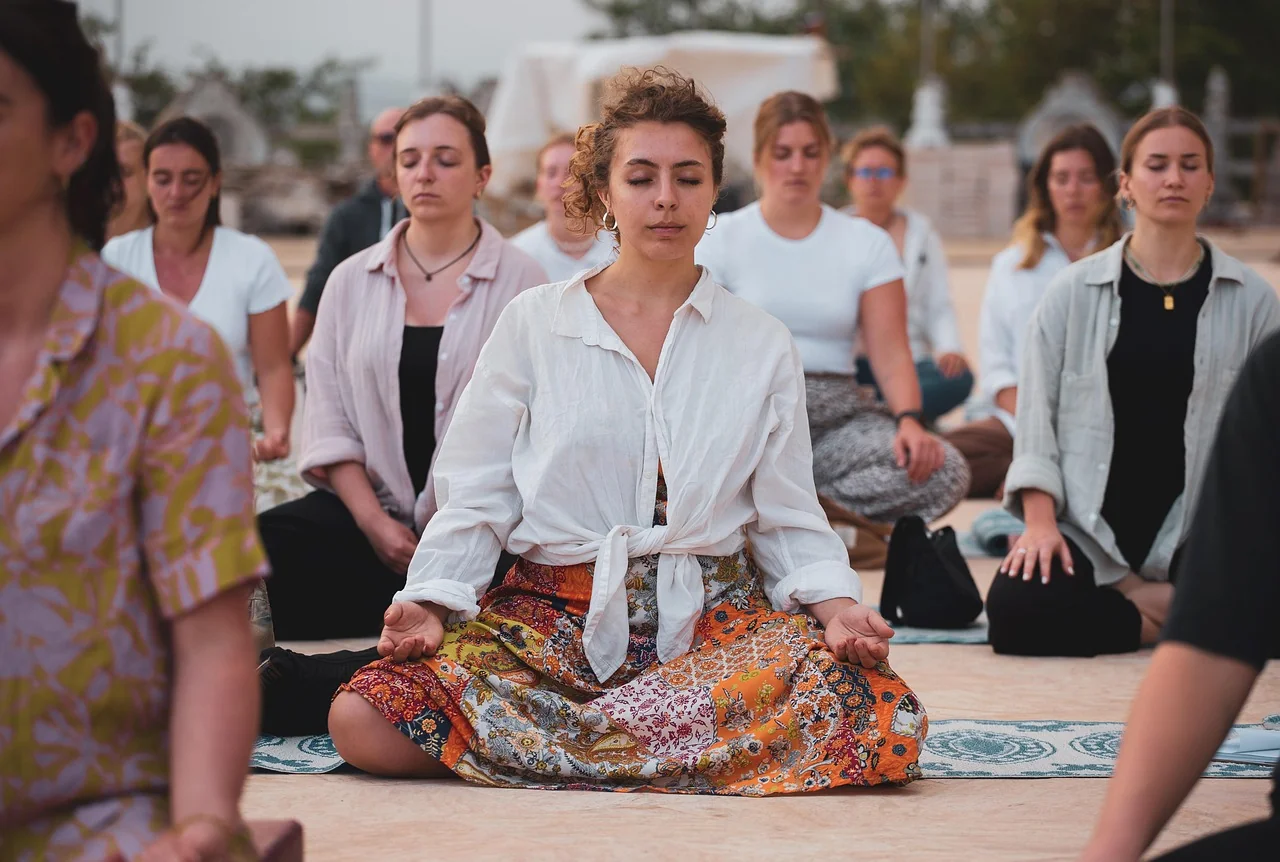Feeling like you're running on empty? In our non-stop world, it's easy to let your own needs fall to the bottom of the list, leaving you drained, stressed, and disconnected. But what if the secret to reclaiming your energy and peace wasn't another complicated life hack, but a simple, consistent practice? The true power of a daily self-care routine isn't found in occasional indulgences, but in building a foundational practice that nourishes you from the inside out.
This guide moves beyond the surface to show you how to weave mindfulness and meditation into the very fabric of your day. We’ll walk through a practical, step-by-step plan—from a serene morning ritual to a peaceful evening wind-down—designed to reduce stress, enhance your focus, and cultivate a lasting sense of calm. Get ready to craft a personalized routine that actually fits your life and transforms your well-being, one mindful moment at a time.
Why Your Daily Self-Care Routine Needs a Foundation of Mindfulness
We often think of self-care as a reward for after we’ve pushed through our to-do list—a manicure, a fancy coffee, an episode of our favorite show. While these treats are lovely, they’re like putting a bandage on a deep cut. True, transformative self-care is proactive, not reactive. It’s about building a resilient inner foundation so that life’s inevitable stresses don’t knock you over.
This is where mindfulness becomes non-negotiable. Mindfulness is the simple, powerful practice of paying attention to the present moment without judgment. When you build your daily self-care routine on this foundation, you shift from merely "getting through the day" to actually engaging with it. Meditation is the dedicated training ground for this skill.
The benefits are more than just a feeling; they're backed by science. A consistent mindfulness practice can:
- Lower cortisol levels, reducing the physical impacts of stress.
- Improve focus and attention by strengthening your brain's ability to filter out distractions.
- Regulate emotions, helping you respond to challenges with clarity instead of reacting from a place of panic or frustration.
Think of your mind as a garden. A reactive self-care approach is like frantically pulling weeds when they’ve already overtaken the flowers. A mindful approach is tending to the soil daily—watering, nourishing, and ensuring the conditions are right for healthy growth, so the weeds have less room to take root. This guide will help you become the gardener of your own mind.
Morning Mindfulness: Setting a Serene Tone for Your Day
How you start your morning often dictates the rhythm of your entire day. Hitting snooze repeatedly and then diving straight into emails and social media puts your nervous system into a reactive, stressed state before you’ve even had a chance to breathe. A mindful morning flips this script, allowing you to lead your day with intention rather than being led by its demands.
This ritual doesn’t need to be long; even 15-20 minutes can create a profound shift.
Waking Up with Intention
Before you even get out of bed, resist the urge to check your phone. Instead, take one conscious minute to connect with yourself.
- Notice the sensation of the sheets, the light in the room, the rhythm of your breath.
- Set a simple, positive intention for the day. It could be as straightforward as, "Today, I will be patient," or "I will move through my day with calm focus." This act programs your mind to look for opportunities to fulfill that intention.
A Simple 5-10 Minute Guided Meditation for Clarity
Now, find a comfortable seated position. You can use a guided meditation app or simply do this on your own.
- Close your eyes and bring your attention to your breath. Don’t try to change it; just feel the air moving in and out.
- Notice the places in your body where the breath is most vivid—the rise and fall of your chest, the air passing through your nostrils.
- When your mind wanders (which it will!), gently and kindly guide it back to the breath. This is the core of the practice—the gentle return, not a perfectly clear mind.
- After 5-10 minutes, slowly open your eyes and take that feeling of centered awareness with you. For a structured approach, a 5 minute daily meditation is a perfect way to build this habit.
Mindful Hydration and Gratitude
Your body has been fasting all night. Before reaching for caffeine, drink a full glass of water. As you do, practice a moment of gratitude. Be thankful for the water, for your body that uses it, and for this new day. This simple act hydrates your body and nourishes your spirit.
Gentle, Mindful Movement
Finally, spend 2-3 minutes on gentle movement. This isn't a workout. It’s about re-inhabiting your body.
- Slowly roll your shoulders.
- Gently tilt your head from side to side.
- Reach your arms overhead and take a deep, full-body stretch.
- Take a slow walk to the kitchen, feeling the soles of your feet on the floor with each step.
This entire sequence creates a buffer of peace that will help you navigate whatever the day brings.
Weaving Mini-Meditations into a Busy Daily Routine
The biggest challenge to any routine is a busy schedule. The "all-or-nothing" mindset can derail you—if you miss your morning session, you might write off the whole day. The solution is to integrate bite-sized mindfulness exercises directly into the cracks of your day. These "mini-meditations" keep you anchored and prove that you don't need a silent retreat to find peace.
The One-Minute Breathing Space for Stress Spikes
When you feel overwhelmed by an email, a difficult conversation, or a looming deadline, this is your go-to reset.
- Minute One: Acknowledge. Briefly scan your body and mind. What are you feeling? Stressed? Anxious? Just name it without judgment.
- Minute Two: Gather. Bring your full attention to the physical sensation of your breath. Focus on the entire inhalation and exhalation, letting it anchor you in the present.
- Minute Three: Expand. Widen your awareness from the breath to include your entire body and the space around you. Then, re-engage with your task, bringing this expanded awareness with you.
Mindful Eating: Transforming Lunch into a Meditative Practice
Instead of eating at your desk while working, dedicate just 5 minutes of your lunch to eating mindfully.
- Look at your food. Notice its colors, textures, and smells.
- Take one bite. Put your fork down.
- Chew slowly, exploring the flavors and sensations.
- Notice the impulse to rush and gently return to the experience of eating. This practice improves digestion, helps you recognize fullness cues, and turns a daily necessity into a moment of true pause.
The "Pomodoro" Meditation: Using Short Breaks for a Reset
If you use the Pomodoro Technique (working in 25-minute blocks with 5-minute breaks), use one of those breaks for a 2-minute awareness reset.
- Set a timer for two minutes.
- Close your eyes and simply listen. Don't label or judge the sounds—the hum of the computer, a distant conversation, a bird outside. Just let the sounds wash over you as pure sensation.
- This "listening meditation" gives your brain a complete break from its visual and cognitive workload, boosting creativity and focus for your next work block.
An Evening Wind-Down: The Ultimate Act of Nightly Self-Care
Just as you started the day with intention, it’s crucial to end it with conscious decompression. A proper wind-down routine signals to your brain and nervous system that it’s time to shift from "doing" to "resting." This is vital for achieving deep, restorative sleep, which is the cornerstone of all other self-care.
A Digital Sunset
Aim to turn off all screens—phones, TVs, laptops—at least 60 minutes before you want to sleep. The blue light emitted from these devices suppresses melatonin production, the hormone essential for sleep. Replace scrolling with a calming analog activity like reading a physical book, gentle tidying, or chatting with a loved one.
A Body Scan Meditation to Release Tension
An evening meditation is perfect for releasing the physical tension you've accumulated throughout the day. Lie down in your bed or on a comfortable surface.
- Close your eyes and take a few deep breaths.
- Bring your awareness to the toes of your left foot. Notice any sensations there—tingling, warmth, pressure. Then, consciously release any tension, imagining your breath flowing into that area.
- Slowly move your attention up through your left foot, ankle, calf, knee, and thigh, repeating the process of noticing and releasing.
- Continue this scan over your entire body—right leg, torso, arms, hands, neck, and head. This practice not only relaxes your muscles but also pulls your mind away from racing thoughts and into the safety of your physical body.
Journaling for Mental Decluttering
If you find your mind is still buzzing with to-do lists or worries, give them a home outside of your head.
- Keep a notebook by your bed and spend 5 minutes "downloading" your brain.
- Write down anything that’s on your mind—unfinished tasks, anxieties, ideas. You don't need to solve anything; the goal is simply to transfer it from your mind to the paper.
- You can also write down one positive moment from your day to end on a note of gratitude.
A Guided Sleep or Loving-Kindness Meditation
As you settle into bed, listening to a guided sleep meditation or a Loving-Kindness (Metta) practice can be incredibly soothing. Loving-Kindness meditation involves silently sending well-wishes to yourself and others. Phrases like, "May I be safe. May I be healthy. May I be at ease," can cultivate a profound sense of peace and connection, washing away the day's irritations and allowing you to drift into a gentle, restorative sleep. For a practice specifically designed to quiet a busy mind, try a meditation to clear your mind before bed.
Creating a Personalized and Sustainable Self-Care Plan
With all these tools, the most important step is to build a daily self-care routine that is uniquely yours and, above all, sustainable. Perfection is the enemy of progress. The goal is consistency, not flawlessness.
Start Small and Build Gradually
If you try to implement a 60-minute routine tomorrow, you will likely burn out. Instead, focus on one tiny habit.
- Week 1: Commit to just one minute of mindful breathing after you brush your teeth in the morning.
- Week 2: Add in the one-minute gratitude practice with your morning glass of water.
- Week 3: Incorporate the two-minute listening meditation during one work break. By starting small, you build confidence and make the routine an automatic part of your life, not another item on your overwhelming to-do list.
A Sample 7-Day Plan for Beginners
To get you started, here is a flexible, one-week plan. Mix and match these elements.
- Day 1: Morning - 3 minutes of mindful breathing. Evening - Digital sunset 30 mins before bed.
- Day 2: Morning - 5-minute guided meditation. Evening - 5-minute journaling.
- Day 3: Daytime - One mindful bite at lunch. Evening - 10-minute Body Scan meditation.
- Day 4: Morning - Set an intention. Daytime - One-Minute Breathing Space during a stress spike.
- Day 5: Morning - Full 15-minute mindful morning ritual. Evening - Listen to a guided sleep meditation.
- Day 6: Daytime - Practice a "Pomodoro" listening break. Evening - A relaxing bath or shower with no phone.
- Day 7: Reflect. What practices felt best? What was challenging? Use this insight to design your ideal week.
Tips for Overcoming Common Obstacles
- "I missed a day!": This is not a failure; it's data. Notice what made it difficult without self-judgment. Simply begin again the next day. The practice is in the returning.
- "I feel too restless to meditate.": This is incredibly common. Instead of fighting it, make the restlessness your object of meditation. Observe the feeling of agitation in your body with curiosity. Where do you feel it? What are its qualities? Often, this mindful observation itself causes the restlessness to dissipate.
- "I don't have a quiet space.": You don't need one. Meditation isn't about eliminating noise, but about changing your relationship to it. Practice noticing sounds without getting caught up in the stories about them. Use traffic noise or household sounds as the anchor for your awareness instead of fighting against them.
Your daily self-care routine is a living, breathing practice that will evolve with you. Some days it will be 20 minutes of dedicated silence; other days it will be three conscious breaths before a meeting. Both are perfect. The true transformation happens not in a single, perfect session, but in the gentle, committed return to the present moment, day after day. By building this foundation of mindfulness, you are not just adding another task to your life—you are fundamentally changing your experience of it, creating a life filled with more peace, purpose, and presence. For more comprehensive strategies, explore these proven ways to decrease stress and anxiety to further support your well-being journey.
In conclusion, a sustainable daily self-care routine is not an indulgence but a fundamental practice for maintaining our physical, mental, and emotional well-being. The most effective rituals are those woven seamlessly into the fabric of your day, from mindful mornings to restorative evenings. Remember that self-care is a deeply personal journey; what works for one person may not work for another. The key is to start small, focusing on consistency over complexity, and to listen to what your mind and body truly need. This is not about achieving perfection but about making a committed investment in yourself. Begin by integrating just one or two of the practices discussed, allowing them to become non-negotiable pillars of your day. By consistently honoring this commitment to yourself, you build resilience, enhance your capacity for joy, and cultivate a life of greater balance and fulfillment. You are worthy of this daily care.


